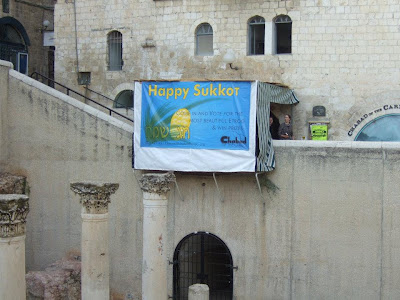Happy Sukkot!
Bible Feasts:
Paul said in Colossians 2:16-17 that the Jewish feasts and celebrations were a shadow of the things to come through Jesus Christ. And though as Christians we may not commemorate these holidays in the traditional biblical sense, as we discover the significance of each, we will certainly gain a greater knowledge of God's Word, an improved understanding of the Bible, and a deeper relationship with the Lord.
Sukkot - Feast of Tabernacles or Feast of Booths:
Sukkot or the Feast of Tabernacles is a week-long fall festival commemorating the 40-year journey of the Israelites in the wilderness. It is one of the three great pilgrimage feasts recorded in the Bible when all Jewish males were required to appear before the Lord in the Temple in Jerusalem. The word Sukkotmeans "booths." Throughout the holiday, Jews continue to observe this time by building and dwelling in temporary shelters, just like the Hebrew people did while wandering in the desert. This joyous celebration is a reminder of God's protection, provision, and faithfulness.
Time of Observance:
Sukkot begins five days after Yom Kippur, from the 15-21 day of the Hebrew month of Tishri (September or October).
Russian
Photo by Steve Martin
in Jerusalem area succa - 2009
Have succa will travel!
Knowing the faith of the early American settlers,
am sure they knew of the Feasts of the Lord
and in giving Thanksgiving to Him!
Fruits of the Harvest - Succot!
Photo by Steve Martin - 2009 in Jerusalem
- on the Vision for Israel Succot Celebration tour
with Barry Segal
Happy Sukkot to our Jewish friends, and those who love Israel worldwide! The Lord's blessings be on ye heads!
Steve and Laurie Martin
Love For His People, Inc.
More on the Feast of Tabernacles (Sukkot)
from a Christian perspective
(as shared by Mary Fairchild):
Scripture Reference:
About Sukkot or the Feast of Tabernacles:
The Bible reveals dual significance in the Feast of Tabernacles. Agriculturally, Sukkot is Israel's "thanksgiving," a joyous harvest festival to celebrate the ingathering of grain and wine. As an historical feast, it's main characteristic is the requirement to dwell in temporary shelters or booths in remembrance of God's protection, provision and care during their 40 years in the wilderness. There are many interesting customs associated with the celebration of Sukkot. These are explained in detail by About.com's Judaism Guide, Ariela Pelaia.
Jesus and Sukkot:
During Sukkot, two important ceremonies took place. The Hebrew people carried torches around the temple, illuminating bright candelabrum along the walls of the temple to demonstrate that the Messiah would be a light to the Gentiles. Also, the priest would draw water from the pool of Siloam and carry it to the temple where it was poured into a silver basin beside the altar. The priest would call upon the Lord to provide heavenly water in the form of rain for their supply. During this ceremony the people looked forward to the pouring out of the Holy Spirit. Some records reference the day spoken of by the prophet Joel.
In the New Testament, Jesus attended the Feast of Tabernacles and spoke these amazing words on the last and greatest day of the Feast: "If anyone is thirsty, let him come to me and drink. Whoever believes in me, as the Scripture has said, streams of living water will flow from within him." (John 7:37-38 NIV) The next morning, while the torches were still burning Jesus said, "I am the light of the world. Whoever follows me will never walk in darkness, but will have the light of life." (John 8:12 NIV)
More Facts About Sukkot:
- The booth of Sukkot is called a sukkah. These shelters consist of at least three walls and are framed with wood and canvas. The roof or covering is made from cut branches and leaves, placed loosely atop, leaving open space for the stars to be viewed and rain to enter.
- It is common to decorate the sukkah with flowers, leaves and fruits.
- Today, the requirement to dwell in the booth can be met by eating at least one meal a day in it. However, some Jews still sleep in the sukkah.
- Since Sukkot is a harvest celebration, typical foods include lots of fresh fruits and vegetables.
- More about Sukkot.










.jpg)
.jpg)
.jpg)
.jpg)
.jpg)













